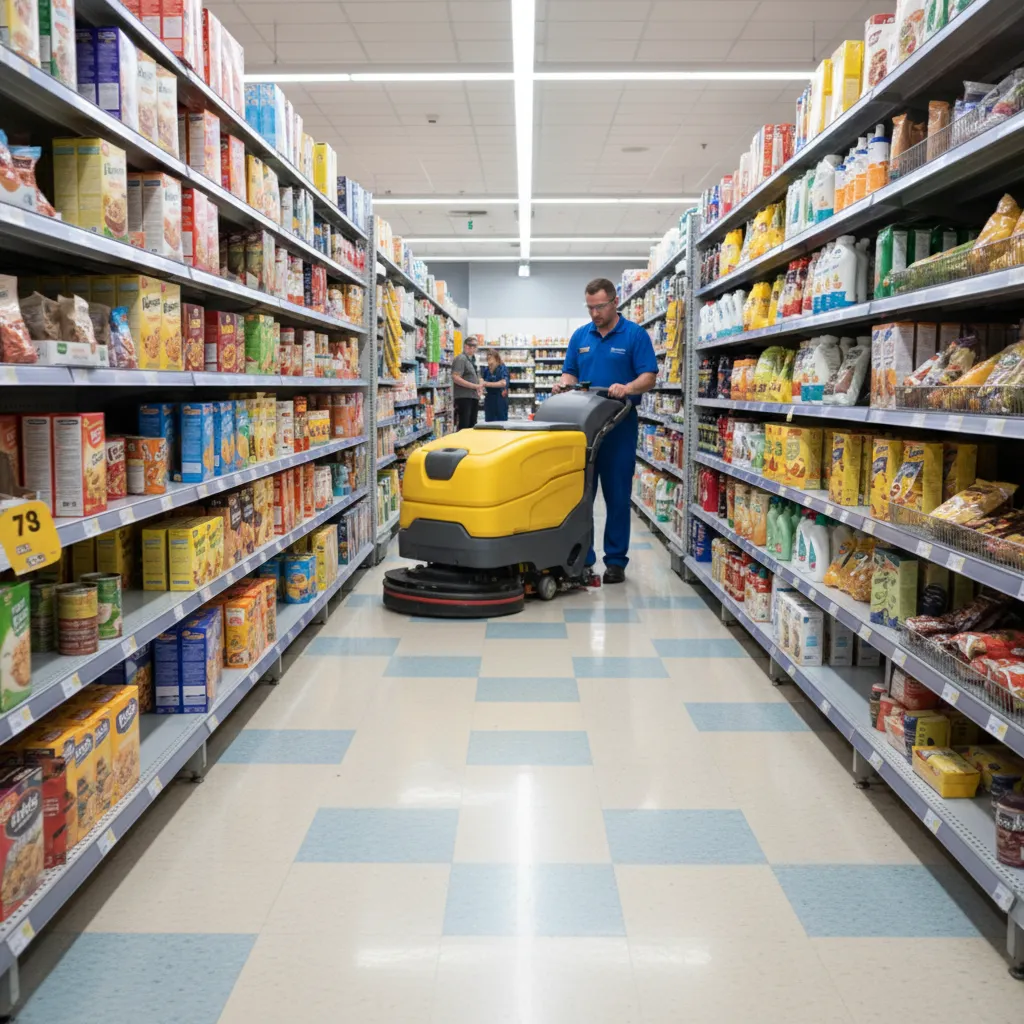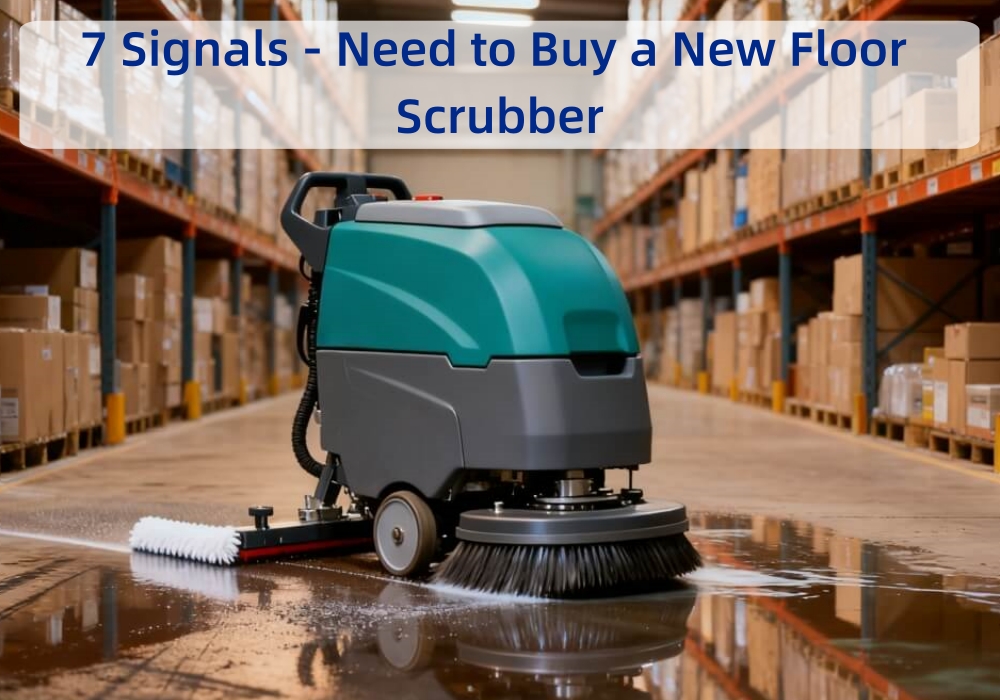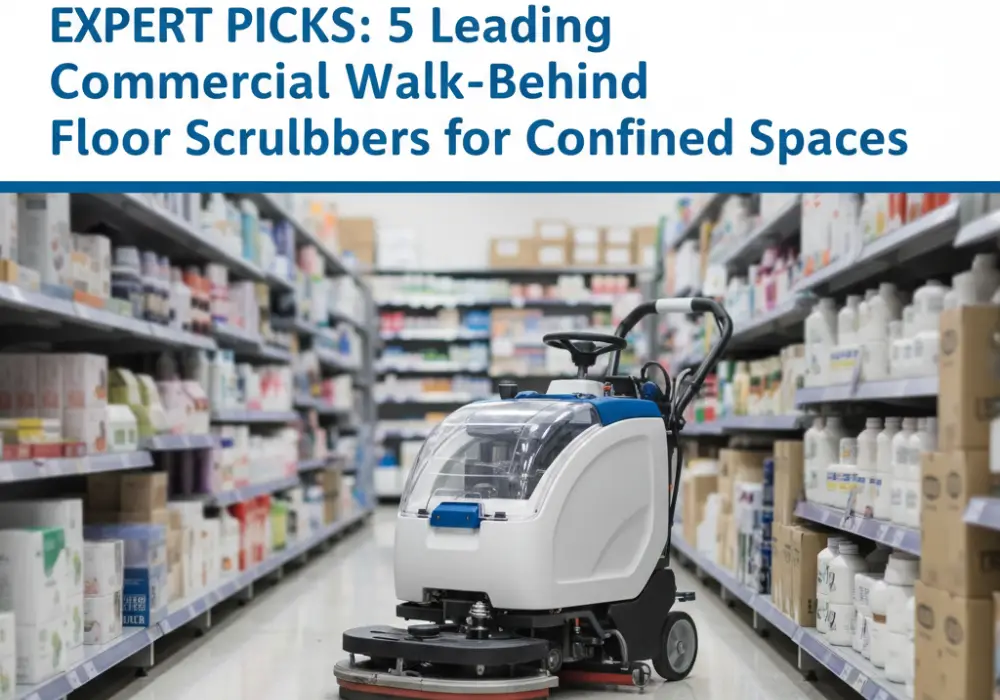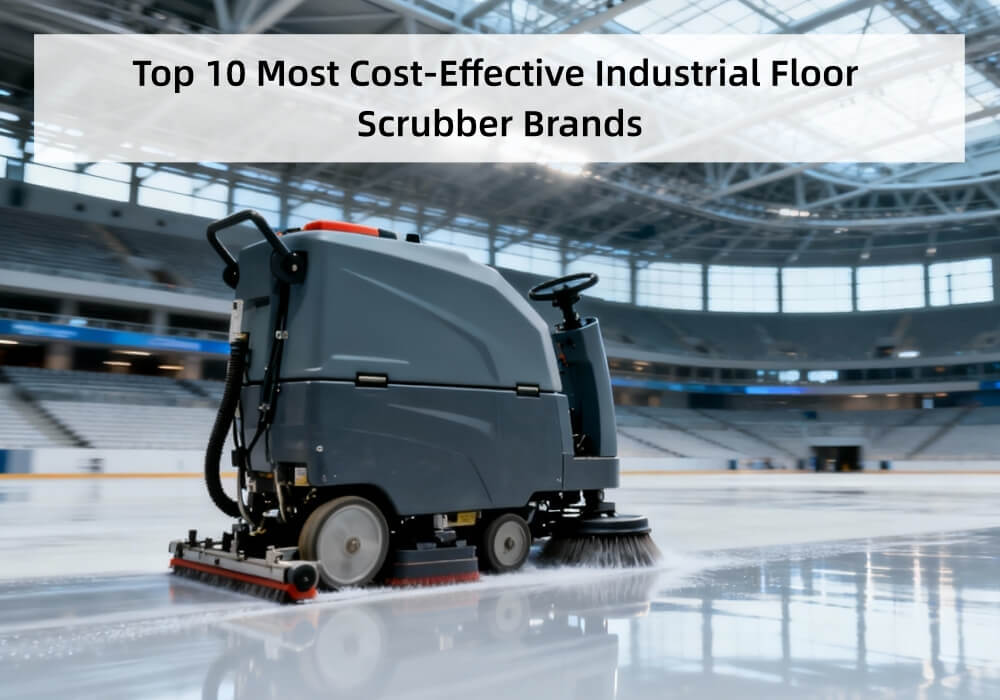Cleaning tight spaces is a big problem. Narrow hallways, cluttered stock rooms, and tight checkout aisles are hard to clean well. You often use a mop and bucket. This is slow, leaves floors wet, and does not deep clean. A standard commercial floor scrubber is too big to fit.
You need a special tool. A compact, commercial walk-behind floor scrubber is the answer. These machines are built to fit in small areas. They scrub, clean, and dry the floor in one pass. This saves time, makes floors safer, and gives you a better clean.
This guide helps you pick the right commercial walk-behind scrubber. We will show you how to measure your space. We will also give you our expert picks for the 5 best machines for confined spaces.

Understanding the Confined Space Cleaning Challenge
What is a confined space in cleaning? It is not just a small closet. It is any area where a standard machine cannot move.
This includes:
- Retail aisles and checkout lanes
- Hospital patient rooms
- School
- Quick-service restaurant kitchens
- Narrow office hallways
- Small storage rooms
Statistics show this is a common problem. Many older commercial doorways are only 32 inches wide. Some modern retail aisles shrink to 36 inches or less, especially with temporary displays. Standard scrubbers, with 24-inch or 28-inch cleaning paths, are just too wide and long to turn around.
Key benefits of specialized compact equipment vs. standard commercial scrubbers:
- Access: They fit through narrow doors and down tight aisles.
- Maneuverability: They have a tighter turning radius. You can clean around obstacles easily.
- Safety: They dry the floor instantly. This cuts the risk of slip-and-fall accidents. A mop leaves floors wet.
- Efficiency: You clean much faster than with a mop. You get a deeper, more hygienic clean.
- Storage: They take up very little space in a utility closet.
How to Measure Your Facility for the Right Scrubber Size
Do not guess. You must measure your facility before you shop. A machine that is one inch too wide is a machine you cannot use. Take 15 minutes to measure. It will save you a big headache.
Critical Measurements to Take Before Buying a Commercial Walk-Behind Floor Scrubber
Get a tape measure. You need to find your "pinch points." These are the tightest spots in your building.
- Doorway Width Measurement: Measure your narrowest doorway. Do not measure the wall opening. Measure the usable space inside the door frame. Look for pinch points like panic bars or door handles that stick out. Your machine must be narrower than this.
- Aisle Width Assessment: Go to your most cluttered aisle. Measure the width at its narrowest point. But width is not the only problem. You need to turn around. Can a machine do a 180-degree turn in that aisle? This is why you must check the "turning radius" specification.
- Storage Space Evaluation: Where will you park the scrubber? Measure your utility closet. You need space for the machine. You also need space for a person to stand next to it to fill, empty, and charge it.
| Measurement Point | Target Scrubber Dimension | Why It's Critical |
| Narrowest Doorway | Scrubber Width ≤Usable Door Width≤-1 inch | Prevents damage to the machine and door frame. |
| Narrowest Aisle | Scrubber Width < Aisle Width | Ensures the machine can pass without hitting shelves. |
| Aisle Width for Turn | Scrubber Length + Turning Radius ≤ Aisle Width | Ensures the machine can perform a 180-degree turn. |
| Storage Closet | Machine Height (Handle Down) ≤ Shelf/Door Height | Confirms the machine can be stored when not in use. |
The 5 Best Commercial Walk-Behind Floor Scrubbers for Confined Spaces
We reviewed dozens of commercial walk-behind floor scrubbers. We focused on size, maneuverability, and real-world performance. Here are our top 5 picks for tight spaces.
| Model | Category | Cleaning Path | Solution Tank | Key Feature for Confined Spaces |
| LVTONG LT-S530X | Best Overall for Tight Spaces | 21 in (530mm) | 13.2 gal (50L) | Balanced size/efficiency, Anti-collision wheels |
| Viper AS380/15B | Best Budget-Friendly Option | 15 in | 4 gal | Extremely compact and lightweight design |
| Kärcher BR 35/12 C Bp | Best for Extremely Narrow Aisles | 14 in | 3.1 gal | Rotating brush head (200° pivot) for zero-turn |
| LVTONG Q5 | Best Battery Life in Compact Design | 20 in (510mm) | 13.2 gal (50L) | Double 100Ah battery setup for extended runtime |
| Tennant T300 | Best for Healthcare Facilities | 17 in (varies) | 11 gal (varies) | Quiet-Mode (57.5 dBA), optional ec-H2O |
Best Overall for Tight Spaces: LT-S530X Walk Behind Floor Scrubber Machine

We picked the LVTONG LT-S530X as the best all-rounder. It hits the perfect balance between a good cleaning path and a compact body.
- Key Specifications: It has a 530mm (21-inch) cleaning path. This is wide enough to clean small hallways or store aisles quickly. And the walk-behind floor scrubber has an ultra-narrow body of 50cm. You can operate the compact floor scrubber easily. It features a 62L solution tank and a 65L recovery tank.
- Maneuverability: This model is designed to be flexible. The squeegee and brush deck are protected by anti-collision wheels. It moves easily around shelves and furniture. The handle is simple and ergonomic.
- Battery and Performance: It runs on a 24V100AH lithium battery or a lead-acid battery. This gives you solid runtime for small-to-medium facilities. It's a reliable, classic design that is easy to use and maintain.
- Real-World Use: This machine is a workhorse for small supermarkets, office buildings, and schools. It’s big enough to be efficient but small enough to fit.
Best Budget-Friendly Option: Viper AS380/15B Scrubber
For small businesses on a tight budget, the Viper AS380/15B gets the job done well.
- Cost-Effectiveness: This machine focuses on core cleaning. It strips away expensive features but keeps a commercial-grade motor and frame. It provides great value.
- Key Specifications: It has a 15-inch cleaning path and compact 4-gallon solution and recovery tanks. This keeps the body very small and light. The battery operation means you are not tied to a cord.
- Limitations: Compared to premium models, its smaller tanks mean more stops to fill and empty in larger areas. The runtime is good for small jobs but not for hours of continuous use.
Best for Extremely Narrow Aisles: Kärcher BR 35/12 C Bp
When every inch matters, you need a machine like the Kärcher BR 35/12 C Bp.
- Industry-Leading Narrow Design: This scrubber has a 14-inch cleaning path. Its key feature is a rotating brush head and squeegee system that pivots 200 degrees.
- Special Maneuverability: The rotating head lets you clean right up to a wall, then turn and clean backward. It can turn on the spot. It is built for U-turns in the most cluttered spaces.
- Applications: This is built for convenience stores, quick-service restaurant kitchens, and grocery checkout lanes. It cleans places only a mop could go before.
Best Battery Life in Compact Design: Q5 Industrial Walk Behind Floor Scrubber

If you have larger "confined" areas, you need runtime. The LVTONG Q5 industrial walk-behind floor scrubber delivers power and endurance in a maneuverable 20-inch package.
- Extended Runtime: The Q5's main feature is its powerful battery system. You can use the floor cleaning machine for 4 hours without a water change. It uses a 24/100Ah large-capacity battery setup. This gives it fantastic runtime, letting you clean longer without stopping to charge.
- Key Specifications: It has a 510mm (20-inch) cleaning path. It also has a large 50L solution and 55L recovery tanks. This means you clean more floor and stop less often for refills.
- Balance of Size and Duration: This is the perfect machine for a hospital floor or a school wing. These areas have many rooms and corridors. The Q5 industrial floor scrubber is small enough to get in, but it has the battery to clean the whole area in one go.
Best for Healthcare Facilities: Tennant T300
Hospitals and clinics have unique needs. They need machines that are not just small, but also quiet and hygienic. Our pick is the Tennant T300.
- Quiet Operation: This machine has a "Quiet-Mode" that runs at just 57.5 dBA. That is quiet enough to use in corridors without disturbing patients, even during the day.
- Sanitization Features: It can be equipped with Tennant's ec-H2O NanoClean technology. This system electrically converts water into a cleaning solution, reducing the need for many chemicals. The tanks are also designed for easy cleaning.
- Maneuverability: The 17-inch path model is compact and easy to guide. It moves smoothly around hospital beds, IV poles, and medical carts.
Key Features to Consider for Confined Space Scrubbers
Before you buy, compare these key features.
| Feature | Best for Confined Spaces | Best for Efficiency (Trade-Off) | Why it Matters |
| Cleaning Path | 15 inches or less | 20 inches or more | Determines the narrowest aisle you can clean. |
| Turning Radius | Tight / Zero-Turn | Not a priority | Allows 180° turns in narrow hallways. |
| Tank Capacity | Small (4-8 gallons) | Large (12+ gallons) | Small tanks allow for a more compact body. |
| Battery Tech | Lithium-ion | AGM/Lead-Acid | Lithium is lighter and charges faster, ideal for small spaces. |
| Noise Level | Under 60 dBA | Not a priority | Essential for day cleaning in offices or healthcare. |
Size and Dimension Considerations
- Cleaning Path vs. Efficiency: A 20-inch path cleans much faster than a 15-inch path. But a 15-inch path fits in more places.
- Tip: Pick the widest path that can safely fit through your narrowest pinch point.
- Height and Storage: Check the machine's height. Can it fit under shelves? Does the handle fold down for storage? Check the total length and width of your storage closet.
Maneuverability Features That Matter
- Turning Radius: This is a critical spec. It tells you the smallest circle the machine can turn in. A "tight" or "zero-turn" radius is best for confined spaces.
- Handle Design: Look for an adjustable or pivoting handle. This lets you change the angle to clean under tables or get closer to walls.
Tank Capacity vs. Size Trade-offs
- Optimal Tank Size: Big tanks (13-15 gallons / 50-55L) mean you clean longer without stopping. But water is heavy. Big tanks make the machine bigger and harder to push.
- Refill Frequency: For a 1,000 sq. ft. shop, a small 5-gallon tank is fine. For a 10,000 sq. ft. office floor, you want at least a 10-gallon tank to be efficient.
Battery Technology and Runtime
- Battery Type: Most compacts use AGM (Absorbent Glass Mat) batteries. They are sealed and maintenance-free. Newer, more expensive models might offer Lithium-ion. Lithium is lighter, charges faster, and lasts longer.
- Charging: How long does a full charge take? (Usually 6-8 hours). Does it need a special charging station? Make sure you have a safe, dry place to charge the machine overnight.
Maintenance Considerations for Compact Scrubbers
Compact machines need regular care. Their small parts can get clogged if you ignore them.
- Unique Challenges: You must empty and rinse the recovery tank after every use. In a small tank, mold and bacteria can build up fast. Squeegee blades must be checked daily for tears.
- Space-Saving Maintenance: You don't need a big room. Your "station" can just be a corner with a floor drain or utility sink. Keep a brush, clean rags, and a hose there.
- Preventative Schedule: Follow a simple schedule:
- Daily: Empty and rinse both tanks. Wipe down squeegees. Place the battery on the charger.
- Weekly: Check brushes/pads for wear. Check filters.
- Monthly: Check all hoses for cracks or clogs.
Conclusion
Picking the right compact walk-behind floor scrubber is not about finding the smallest one. It is about finding the right one for your doors, your aisles, and your runtime needs. Measure your space, check your pinch points, and then use this guide to choose a machine that will solve your cleaning challenge.
Welcome to contact us to explore more details of the commercial walk-behind floor scrubbers. We will give you more professional advice to help you choose the right scrubbers for your spaces.



